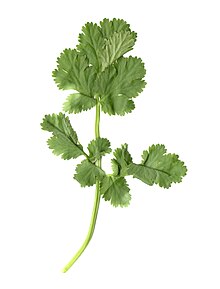Glossary of leaf morphology
Appearance
You can help expand this article with text translated from the corresponding article in French. (January 2016) Click [show] for important translation instructions.
|
This article may require cleanup to meet Wikipedia's quality standards. The specific problem is: Links inconsistently lead to wiktionary, to this article, or to sub-stubs. (September 2015) |





In botany, leaf shape is a description of the form of the part of a plant known as the leaf. Leaf shape is a component of plant morphology used in the description and taxonomy of plants. being one of the more visible features, leaf shape is commonly used for plant identification. leaves may be simple (a single leaf blade or lamina) or compound (with several leaflets), have a regular or irregular border, be smooth or bearing hair, bristles or spines. In compound leaves, the arrangement and form of the edges of the leaflets determine the overall leaf shape, as well as the arrangement of the veins.
List of leaf shapes
Leaf shape may be described with a variety of terms, including the following (with botanical Latin in italics in brackets).
- Acicular (acicularis): Slender and pointed, needle-like
- Acuminate (acuminata): Tapering to a long point
- Acute: Pointed, having a short sharp apex angled less than 90°
- Aristate (aristata): Ending in a stiff, bristle-like point
- Asymmetrical: With the blade shape different on each side of the midrib
- Basal: Arising from the root crown, bulb, rhizome or corm, etc., as opposed to cauline
- Bipinnate (bipinnata): Each leaflet also pinnate
- Biternate: divided into three leaflets, themselves again divided
- Caudate: Tailed at the apex
- Cauline: Borne on the stem, as opposed to basal
- Compound: Not simple; the leaf is broken up into separate leaflets, and the leaf blade is not continuous
- Cordate (cordata): Heart-shaped, with the petiole or stem attached to the cleft
- Cuneate (cuneata): Triangular, stem attaches to point
- Deltoid (deltoidea) or deltate: Triangular, stem attaches to side
- Digitate (digitata): Divided into finger-like lobes
- Elliptic (elliptica): Oval, with a short or no point
- Entire: Having a smooth margin without notches or indentations
- Falcate (falcata): Sickle-shaped
- Fenestrate (fenestrata): "Windowed" with holes (e.g. Monstera deliciosa or Aponogeton fenestralis), or window-like patches of translucent tissue. (cf. Perforate)
- Filiform (filiformis): Thread- or filament-shaped
- Flabellate (flabellata): Semi-circular, or fan-like
- Hastate (hastata), spear-shaped: Pointed, with barbs, shaped like a spear point, with flaring pointed lobes at the base
- Laciniate: Very deeply lobed, the lobes being very drawn out, often making the leaf look somewhat like a branch or a pitchfork
- Laminar: Flat (like most leaves)
- Lance-shaped, lanceolate (lanceolata): Long, wider in the middle
- Linear (linearis): Long and very narrow
- Lobed (lobata): With several points
- Lorate (loratus): Having the form of a thong or strap
- Mucronate: Ending abruptly in a sharp point[1]
- Obcordate (obcordata): Heart-shaped, stem attaches to tapering point
- Oblanceolate (oblanceolata): Top wider than bottom
- Oblong (oblongus): Having an elongated form with slightly parallel sides
- Obovate (obovata): Teardrop-shaped, stem attaches to tapering point
- Obtuse (obtusus): Blunt, forming an angle > 90°
- Orbicular (orbicularis): Circular
- Ovate (ovata): Oval, egg-shaped, with a tapering point
- Palmate (palmata): Consisting of leaflets[2] or lobes[3] radiating from the base of the leaf.
- Pandurate: fiddle-shaped
- Pedate (pedata): Palmate, with cleft lobes[4]
- Peltate (peltata): Shield-shaped with stem attached underneath (cf. pelta)
- Perfoliate (perfoliata): Stem through the leaves
- Perforate (perforata): marked with patches of translucent tissue, as in Crassula perforata and Hypericum perforatum, or perforated with holes (cf. "Fenestrate")
- Pinnate (pinnata): Two rows of leaflets
- Odd-pinnate, imparipinnate: Pinnate with a terminal leaflet
- Paripinnate, even-pinnate: Pinnate lacking a terminal leaflet
- Pinnatifid and pinnatipartite: Leaves with pinnate lobes that are not discrete, remaining sufficiently connected to each other that they are not separate leaflets.
- Bipinnate, twice-pinnate: The leaflets are themselves pinnately-compound
- Tripinnate, thrice-pinnate: The leaflets are themselves bipinnate
- Tetrapinnate: The leaflets are themselves tripinnate.
- Pinnatisect (pinnatifida): Cut, but not to the midrib (it would be pinnate then)

- Plicate (plicatus, plicata): folded into pleats, usually lengthwise, serving the function of stiffening a large leaf.
- Pungent (spinose): Having hard, sharp points.
- Reniform (reniformis): Kidney-shaped
- Retuse: With a shallow notch in a broad apex
- Rhomboid (rhomboidalis): Diamond-shaped
- Round (rotundifolia): Circular
- Sagittate (sagittata): Arrowhead-shaped
- Simple: Leaf blade in one continuous section, not divided into leaflets (not compound)
- Spear-shaped: see Hastate.
- Spatulate, spathulate (spathulata): Spoon-shaped
- Subulate (subulata): Awl-shaped with a tapering point
- Subobtuse (subobtusa): Somewhat blunted, neither blunt nor sharp
- Sword-shaped (ensiformis): Long, thin, pointed
- Terete: Circular in cross-section; more or less cylindrical without grooves or ridges.
- Semiterete: Rounded on one side, but flat on the other.
- Trifoliate (trifoliata), trifoliolate (trifoliolata), or ternate (ternata): Divided into three leaflets
- Tripinnate (tripinnata): Pinnately compound in which each leaflet is itself bipinnate
- Truncate (truncata): With a squared-off end
- Undulate (undulatus): Wave-like
- Unifoliate (unifoliata): With a single leaf
See also
References
- ^ Mucronate, Answers.com, from Roget's Thesaurus.
- ^ "Cumulative Glossary for Vascular Plants". Flora of New South Wales.
- ^ "palmate (adj. palmately)". GardenWeb Glossary of Botanical Terms.
- ^ "Pedate leaf". Retrieved February 24, 2014.
- ^ "Pedatifid". Retrieved February 24, 2014.
Bibliography
- "Leaves"., in Massey & Murphy (1996)
- "Shapes"., in Massey & Murphy (1996)
- Massey, Jimmy R.; Murphy, James C. (1996). "Vascular plant systematics". NC Botnet. University of North Carolina at Chapel Hill. Retrieved 19 January 2016.
{{cite web}}: Invalid|ref=harv(help)
